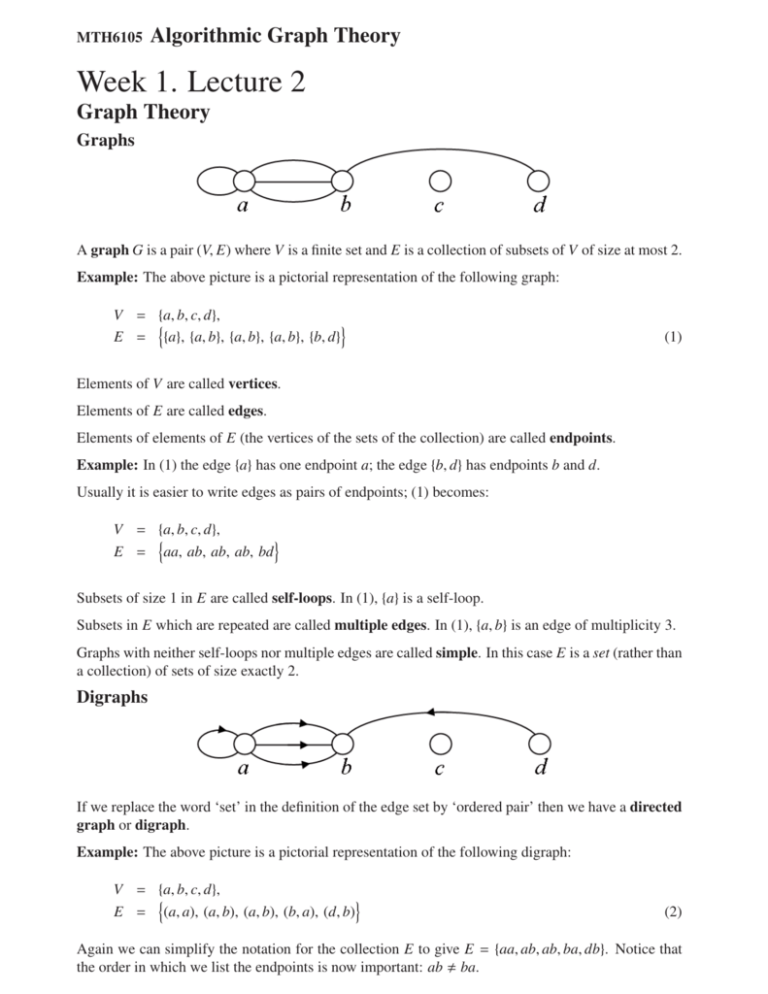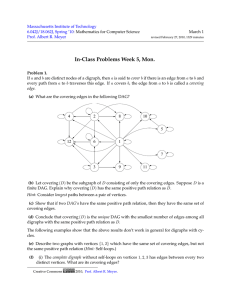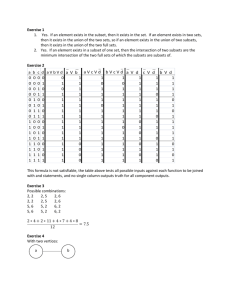Algorithmic Graph Theory: Graphs & Digraphs
advertisement

MTH6105
Algorithmic Graph Theory
Week 1. Lecture 2
Graph Theory
Graphs
A graph G is a pair (V, E) where V is a finite set and E is a collection of subsets of V of size at most 2.
Example: The above picture is a pictorial representation of the following graph:
V = {a, b, c, d},
n
o
E = {a}, {a, b}, {a, b}, {a, b}, {b, d}
(1)
Elements of V are called vertices.
Elements of E are called edges.
Elements of elements of E (the vertices of the sets of the collection) are called endpoints.
Example: In (1) the edge {a} has one endpoint a; the edge {b, d} has endpoints b and d.
Usually it is easier to write edges as pairs of endpoints; (1) becomes:
V = {a, b, c, d},
n
o
E = aa, ab, ab, ab, bd
Subsets of size 1 in E are called self-loops. In (1), {a} is a self-loop.
Subsets in E which are repeated are called multiple edges. In (1), {a, b} is an edge of multiplicity 3.
Graphs with neither self-loops nor multiple edges are called simple. In this case E is a set (rather than
a collection) of sets of size exactly 2.
Digraphs
If we replace the word ‘set’ in the definition of the edge set by ‘ordered pair’ then we have a directed
graph or digraph.
Example: The above picture is a pictorial representation of the following digraph:
V = {a, b, c, d},
n
o
E = (a, a), (a, b), (a, b), (b, a), (d, b)
(2)
Again we can simplify the notation for the collection E to give E = {aa, ab, ab, ba, db}. Notice that
the order in which we list the endpoints is now important: ab , ba.
The following definitions apply to graphs or digraphs:
Two vertices are adjacent if they appear in the same subset of E. They are said to be joined by this
edge.
An edge and its endpoints are said to be incident with each other. For example, in (1) or (2) a is
incident with ab (three times for the graph; twice for the digraph); and bd is incident with b and
with d.
The number of edges incident with a vertex v is the degree of v, denoted by d(v). Self-loops count
twice. In (1) or (2) we have d(a) = 5, d(b) = 4, d(c) = 0 and d(d) = 1.
A vertex of degree zero is said to be isolated.
For digraphs we distinguish between ‘indegree’ and ‘outdegree’ but we defer discussion until Week 5.
In many cases a pictorial representation of a graph or digraph (as used above) is just as good as the
mathematical notation of sets and subsets. However, it is important to realise that this picture is not
unique. For example, the following picture represents the same structure of vertex-edge incidences as
the graph defined in (1):
The graph represented here is not identical to (1) only in that the vertex names are different. The way
in which the edges cross over each other may or may not be of interest (perhaps the graph is model
of a road network); similarly the colours on the vertices may be important (perhaps they represent
different countries). And the size of the vertices may mean something (populations?) However, these
details are not part of the mathematical object which is the graph G.











